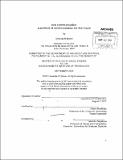| dc.contributor.advisor | Antoni Muntadas. | en_US |
| dc.contributor.author | Moore, Amanda M | en_US |
| dc.contributor.other | Massachusetts Institute of Technology. Dept. of Architecture. | en_US |
| dc.date.accessioned | 2012-01-12T19:25:55Z | |
| dc.date.available | 2012-01-12T19:25:55Z | |
| dc.date.copyright | 2011 | en_US |
| dc.date.issued | 2011 | en_US |
| dc.identifier.uri | http://hdl.handle.net/1721.1/68416 | |
| dc.description | Thesis (S.M.)--Massachusetts Institute of Technology, Dept. of Architecture, 2011. | en_US |
| dc.description | Title "Communication" in pages top margin and in abstract are shown as crossed off. Cataloged from PDF version of thesis. | en_US |
| dc.description | Includes bibliographical references (p. 104-106). | en_US |
| dc.description.abstract | The rapid transmutation of technology enables us to experience the world indirectly much of the time. As it becomes less possible to exist without new modes of technological communication -cellular phones, global positioning systems, portable computers, Youtube TM and Skype TM- our relationship to the world around us transforms into a series of impersonal contact-less transactions. These technologies simultaneously augment and conceal an already present void in communication, which prevents individuals from achieving mutual understanding. This void in communication originates from and is perpetuated by the complex and varied meaning of signs and symbols, with which we use to convey and interpret information. How can we, as individuals, negotiate these technologies, enabling them to fulfill their function of resolving this ever-present void in communication? Rather than persisting in futile attempts to circumnavigate this void in communication through these technologies, I propose a repurposing of these devices, enabling communication directly with the problem, the void. Addressing the void directly will facilitate successful communication. I argue for a new method, "Gommunication" or Void Communication as a means to achieve mutual understanding. I aim to demonstrate the need for the Gommunication method by first acknowledging and identifying this void. I will support the method based on primary examples of telecommunications experiments, which, although carried out for various different purposes, suggest that Communication is possible. I will provide evidence of my own experiments in Gemmunication proving that this method is capable of achieving its desired result. I will conclude with a discussion of potential future applications of Gemmunication. | en_US |
| dc.description.statementofresponsibility | by Amanda M. Moore. | en_US |
| dc.format.extent | 106 p. | en_US |
| dc.language.iso | eng | en_US |
| dc.publisher | Massachusetts Institute of Technology | en_US |
| dc.rights | M.I.T. theses are protected by
copyright. They may be viewed from this source for any purpose, but
reproduction or distribution in any format is prohibited without written
permission. See provided URL for inquiries about permission. | en_US |
| dc.rights.uri | http://dspace.mit.edu/handle/1721.1/7582 | en_US |
| dc.subject | Architecture. | en_US |
| dc.title | Void communication : a method of communication for the future | en_US |
| dc.title.alternative | Communication | en_US |
| dc.title.alternative | Method of communication for the future | en_US |
| dc.type | Thesis | en_US |
| dc.description.degree | S.M. | en_US |
| dc.contributor.department | Massachusetts Institute of Technology. Department of Architecture | |
| dc.identifier.oclc | 768479638 | en_US |
